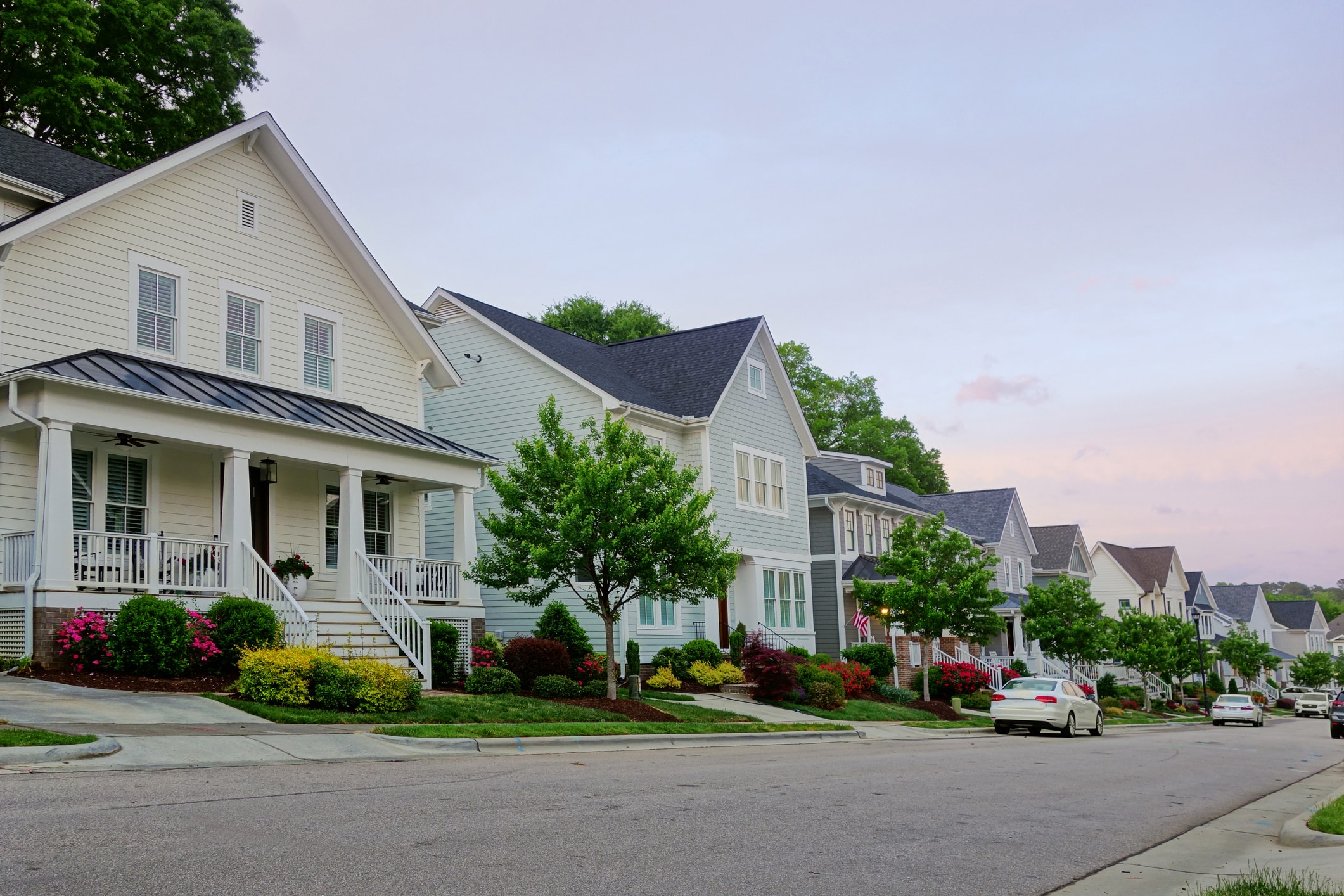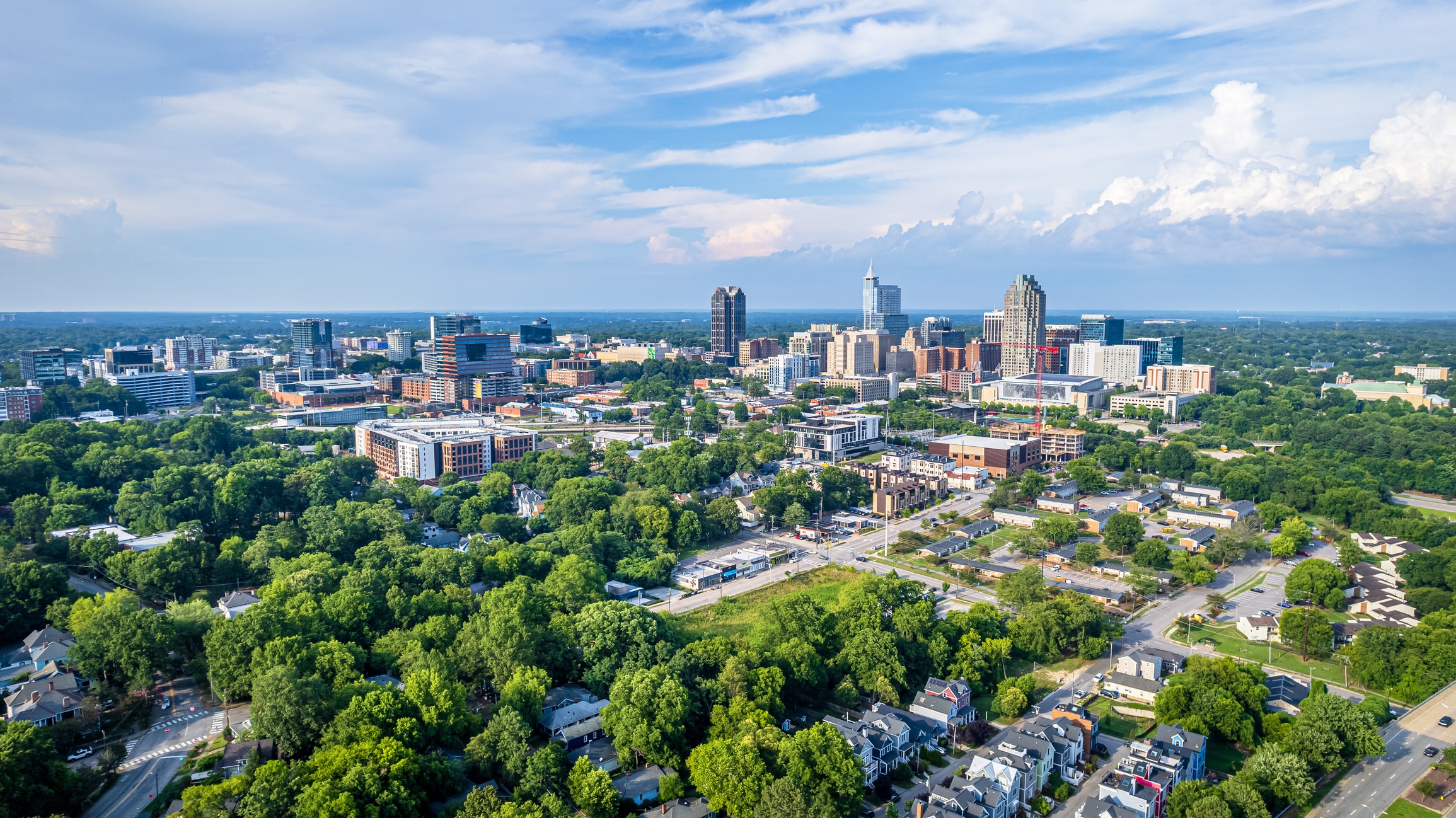(Updated September 28, 2024)
Whether you’re looking for mild winters, a booming economy, or just some good BBQ (we’re not judging), there are a lot of reasons to consider moving to Raleigh, NC.
Nestled in a three-city triangle with Durham and Chapel Hill, there’s always something new to discover within this fast-growing metro area. A vibrant museum and cultural scene has earned Raleigh the nickname “Smithsonian of the South,” while diverse culinary options make it a foodie hotspot. Outdoor enthusiasts and sports fanatics (college football, anyone?) will thrive here, too, with great athletic venues and access to some of America’s most incredible national parks.
Raleigh is the capital of North Carolina, and it’s also the second largest municipality in the state. A mid-sized city — as of 2024, Raleigh has a population of 477,084 — it has an annual growth rate of 3.4 percent. This makes it one of the fastest expanding urban centers in the United States.
And it’s no wonder why. With its robust economy and proximity to nature, moving to Raleigh, NC, might be the perfect choice for you.
Keep reading our Raleigh relocation guide, and we just might have you convinced.
19 Facts to Know Before Moving to Raleigh, NC
1.There’s a story behind Raleigh’s two unique nicknames
Remember that “triangle” Raleigh shares with Durham and Chapel Hill? The area is collectively known as the Research Triangle Region, named after the business park of the same name. Research Triangle Park was created in 1959 through a collaboration between local governments and universities; the idea was to concentrate business and academic brain power in a single physical location, which would hopefully drive new industries and revitalize the local economy.
True to the vision of 1959, today the region is a world-famous hub for medical and other scientific research, with Raleigh making up one “leg” of what’s often simply called “The Triangle.” Ten major institutions of higher learning (more on that later) help feed a booming hi-tech industry and drive the local economy.
Raleigh’s other nickname, “The City of Oaks,” can be traced to European settlers in the 1790s. Fast forward over 200 years, and that moniker is still relevant today: oak trees line Raleigh’s streets, creating a lush, park-like vibe. More than 50 percent of Raleigh is covered in tree canopy, in fact — that’s nearly 9 million trees — making it the third leafiest capital city in America.
2.The job market is booming in multiple industries
Trees aren’t the only green that Raleigh has plenty of — the Research Triangle also helps drive a strong and resilient economy. Local economists predict that inflation will likely decline to 2 percent in 2024, and many industries will experience accelerated growth.

This landscape creates a favorable job market within Raleigh’s top industries, including technology, education, healthcare, life sciences, and manufacturing. That includes companies like Deloitte, IBM, WakeMed, Pantheon, and Siemens, just to name a few.
Most household incomes in Raleigh fall between $52,548 and $87,353 per year. A livable salary for the average family of four with two working adults is $28.35 an hour, while a single adult can live comfortably on $24.70 an hour. Despite costing more than some other parts of North Carolina, Raleigh’s economy and job market offer strong career opportunities.
1. Raleigh is a (relatively) affordable place to live
With its strong economy and great quality of life, it’s no surprise that Raleigh isn’t the cheapest place to live if you’re considering the country as a whole. You’ll save some dough if you’re moving from a much more expensive area, but the cost of living in Raleigh, NC, is only about 2 percent below the national average. It’s also about 3 percent more expensive than other parts of North Carolina.
A family of four in Raleigh should plan to spend about $4,630 a month (after housing costs) — that’s 6 percent higher than Durham and 2 percent higher than Charlotte. Moving to Raleigh, NC, is more expensive than other North Carolina cities, but it’s still a bit cheaper than most of the U.S.
2. Raleigh has no shortage of dynamic places to live
If you’re wondering how big is Raleigh, NC, really? Well, it’s big enough to be broken down into six distinct regions: Downtown, Midtown, North, South, East, and West. Each locale features its own neighborhoods, attractions, and unique character. Where you choose to live is ultimately a matter of preference, but to help make the decision easier, let’s explore all these regions and what they offer.
Downtown Raleigh
This is the main urban center, where you’ll find both municipal and state government offices, along with many of the most significant cultural landmarks. The Museum of Natural Science, North Carolina History Museum, Raleigh Convention Center, Performing Arts Center, and Red Hat Amphitheater are all clustered in Downtown.
In recent years, Downtown Raleigh has become more residential, thanks to an influx of condos, apartments, and townhomes. If you want walkable access to eclectic restaurants, locally owned retailers, and live entertainment, keep this district on your radar.
Midtown Raleigh
This area consists of four neighborhoods: North Hills, Village District, Crabtree Valley, and Five Points. All these neighborhoods connect via the Raleigh Beltway, and each offers attractions in walking distance.
Enjoy an indie film at the 1940s-era Rialto Theater in Five Points. Check out the 220 stores and eateries at Crabtree Valley Mall. Take an outdoor fitness class at Midtown Park in North Hills. Or savor Southern comfort food at the Village District Deli & Grill. As for housing, Midtown has it all, from historic bungalows to modern lofts.

North Raleigh
This location is known for its more suburban, upscale neighborhoods just north of Midtown. In North Raleigh, you’ll find excellent schools, master-planned communities, and outdoor-oriented recreational hotspots like Shelley Lake Park, making it a prime choice for families.
Explore five miles of scenic trails at Durant Nature Preserve, or fish off the docks at Shelley Lake Park. Stroll through boutiques and art exhibits at Lafayette Village, a quaint European-style retail district. Then, bring your appetite to Winston’s Grille, a North Raleigh institution for over 25 years.
South Raleigh
This region, nestled south of Downtown, is one of the city’s fastest-developing areas. Homes are more affordable here than in North Raleigh, plus this area features world-class entertainment venues, irresistible culinary options, and exciting outdoor recreation. Immerse yourself in 23 acres of local and exotic flora at the Juniper Level Botanic Garden. Attend an open-air concert at the Coastal Credit Union Music Park. Or dine at the James’s Beard Award-winning restaurant Poole’s.
East Raleigh
This part of Raleigh is furthest away from the Research Triangle, which lends it a suburban (or even rural) feel. East Raleigh is quiet, safe, and full of stylish houses, from pitched-roof Tudors to mid-century ranch styles.
The area’s most famous attraction is the Historic Oak View County Park, an 1855-era farmstead with a livestock barn, pecan grove, herb garden, picnic facilities, and more. East Raleigh is also home to St. Augustine University, an HBCU (that is, one of the historically Black colleges and universities) that’s been around since 1867, with its stunning campus and thrilling athletic events.
West Raleigh
This district’s primary claim to fame is NC State University, situated in the heart of West Raleigh and known for its top-rated tech and science programs. But that’s not all this vibrant locale has to offer. West Raleigh residential areas are also within walking distance of the North Carolina Museum of Art, North Carolina State Fairgrounds, and Raleigh Little Theater, one of the nation’s oldest community theaters. The State Farmers Market is another must-see attraction, with 75 acres of fresh produce, eateries, artisan shops, and local vendors.
1. Chances are, you’ll want a car to navigate the city
With a bike score of 39, a walk score of 31, and a transit score of 29, Raleigh is not the most accessible place to navigate without a vehicle. While the GoRaleigh bus line is a cost-effective option to commute around the city, most residents prefer to drive their own cars on the I-440 Beltway.
The more urban neighborhoods, such as Downtown and Midtown, are the exception to this rule, and are considered much more walkable. The good news is that Raleigh’s drivers are among the safest in the U.S.
2. Traveling for work or pleasure? Raleigh has you covered
Raleigh is a convenient home base for traveling around or beyond North Carolina, thanks to its central location in the state and easy access to long-distance transportation hubs.
Raleigh-Durham International Airport is a 27-minute drive from Raleigh’s urban center, while Amtrak’s Raleigh Union Station is located within city limits. Catch a nonstop flight to 70 domestic and international cities, or opt for Amtrak with direct routes across North Carolina, as well as to the South and Northeast.

1. The housing costs are pricey, but affordable options do exist
After all that travel, you’ll need a place to lay your head. But unfortunately that won’t come cheap in Raleigh. As of 2024, the median single-family home value in Raleigh is $545,000 (about $236 per square foot). To compare, a single-family home costs $443,000 in Durham, $430,000 in Charlotte, and $305,000 in Greensboro.
Considering the median home price in most U.S. cities is $412,300, buying a house in Raleigh does cost more than the national average. And in this market, that’s really saying something.
But before you sweat this real estate market, remember that renting can be a feasible alternative. The monthly cost of a 950-square-foot apartment in Raleigh is $1,585, versus $1,560 in Durham, $1,651 in Charlotte, $1,302 in Greensboro, and $1,739 across the U.S.
2. Raleigh boasts some of the best schools nationwide
If you have children, check out the different schools before moving to Raleigh, NC. The Wake County Public School District, where Raleigh is located, has an “A” to “A-” rating in academics, teachers, diversity, extracurricular activities, and college readiness.
Raleigh is also home to 10 colleges and universities. We’ve talked about both NC State University and St. Augustine University, but these only scratch the surface of all the higher education options within this metro area. The University of North Carolina in Chapel Hill and Duke University in Durham are just a quick 30-minute drive from Raleigh, too. In fact, Raleigh is currently the second most educated city in the entire U.S. Maybe all those smart folks made a smart choice by moving to Raleigh, NC (hint hint).
3. You’ll love the weather and climate in Raleigh — most of the time
If you’re looking to escape frigid winters or sweltering summers with a move to Raleigh, it’s best to keep your expectations in check. Raleigh has a temperate climate with relatively mild weather year-round. But this city does experience all four seasons, with summer temperatures climbing to the mid-90s, then falling to the 30s or 40s in winter. July, August, and September are the hottest and wettest months. On average, residents can expect about 46 inches of rainfall per year.
Many parts of North Carolina are vulnerable to hurricanes, and Raleigh is no exception. Even though it’s about two hours inland, living in Raleigh requires safety precautions during hurricane season. Fortunately, the winters are manageable here. It can be cold enough to snow, but almost never enough that you’ll need chains or snow tires to get around.
4. Raleigh’s annual tax rates are on par with other US cities
We just covered bad weather, so let’s move on to another not-so-fun fact of life: taxes.
North Carolina has a flat income tax rate of 5.25 percent across all salary brackets, so a resident who earns $70,000 per year will be taxed $10,517. This is relatively affordable, considering income taxes in states such as California, New Jersey, Minnesota, Oregon, Wisconsin, Vermont, and New York range between 7 to 13 percent.
The 2024 sales tax rate in Raleigh is 7.25 percent, and the property tax rate is .96 percent. Both these numbers are slightly above the current North Carolina state average. With that said, most states have a sales tax rate of 4 to 7 percent and a property tax rate of .99 percent, which makes Raleigh taxes fairly comparable to the national average.
5. You can embrace the lake life to your heart’s content
The closest ocean beaches to Raleigh are about a two-hour drive away. But there’s no need to be salty — moving to Raleigh, NC, puts you in convenient proximity to some amazing lakes and rivers. (See what we did there?) Raleigh summers can be humid, so here are a few nearby spots to dive in and cool off.
Lake Raleigh on the NC State University Centennial Campus
Robertson Millpond Preserve about 25 minutes east of Raleigh
Lake Crabtree County Park near the Research Triangle
Neuse River Canoe Trail starting at Falls Lake Dam near West Raleigh
Lake Johnson Park about 15 minutes southeast of Raleigh
Shelley Lake Park near the Sertoma Arts Center in North Raleigh
Lake Howell in Pullen Park between Downtown and NC State University
6. Yes, there are pros and cons of living here
As with any location, there are pros and cons of living in Raleigh, NC. While this city does have many clear selling points to offer new residents, it helps to be aware of the potential drawbacks as well. So, weigh out these pros and cons before your move to Raleigh.
Pros of Moving to Raleigh, NC
A booming job market in many lucrative industries
Top-notch schools for both K–12 and college students
An irresistible culinary scene with Southern and global flavors
Historic landmarks, cultural attractions, and live entertainment
A temperate climate, ideal for water and nature activities
Various urban and suburban neighborhoods to choose from
A safe and comfortable lifestyle, compared to other U.S. cities

Cons of Moving to Raleigh, NC
A more expensive cost of living than most of North Carolina
Downtown traffic congestion on the Raleigh Beltway
A pricier, more competitive housing market than other nearby cities
Relatively low biking, public transit, and walking scores
Humidity in the summers and intense pollen levels in the spring
Risk of hurricanes from June through November
1. Don’t forget to run the cost of actually moving to Raleigh, NC
The cost of living in Raleigh, NC, is a major consideration, of course. But you’ll need to account for another expense, too — the cost of actually moving there. As recent projections show, most Raleigh transplants relocate from California, New York, South Carolina, Virginia, and Florida. If you hire a moving company to make this job easier — and it undoubtedly will — here’s how much it will cost to pack a two- to three-bedroom house and move to Raleigh from each of these states according to MoveBuddha.com.
California to Raleigh: $4,379 - $9,363
New York to Raleigh: $2,179 - $5,352
South Carolina to Raleigh: $1,620 - $4,695
Virginia to Raleigh: $1,376 - $4,118
Florida to Raleigh: $2,129– $5,362
2. Your schedule will be packed with activities all year-round
Moving to Raleigh, NC, will introduce you to a variety of fun activities you won’t find anywhere else. The locals love their concerts (Raleigh has more live music than the rest of NC), art festivals, outdoor recreation, and culinary experiences. No matter the season, there’s always a cool event to check out, so mark your calendar for these must-do activities:
Fall and Winter
The International Festival: September
North Carolina State Fair: October
Moonlight in the Garden: November
Holiday Ice Skating Rink: December–January
Triangle Restaurant Week: January
Spring and Summer
Raleigh also has an immense variety of cultural exhibitions — it’s called the “Smithsonian of the South” for a reason, after all. From world-class museums and artisan markets, to live music performances and theatrical productions, there’s no shortage of ways to embrace Raleigh’s unique, vibrant culture. Here are just a few of the many offerings:
North Carolina Symphony
Red Hat Amphitheater
Triangle Cultural Art Gallery
North Carolina Opera
The Carolina Ballet
North Carolina Museum of Art
Raleigh Little Theater
City Market Arts Collective
Black Box Dance Theatre
Raleigh Symphony Orchestra
The North Carolina Theatre
Raleigh Contemporary Art Museum
3. Are you a sports fan? You’ve come to the right place
Just like anywhere else in the South, Raleigh takes professional and collegiate sports seriously. Cheer on The Wolfpack, NC State’s Division I football team, at Carter-Finley Stadium. Catch the former Stanley Cup-winning North Carolina Hurricanes dominate the rink at the newly renovated Lenovo Center. Or drive 20 minutes to Cary and watch the North Carolina Courage, three-time NWSL women’s soccer league champions, play at WakeMed Park.

1. Raleigh is a foodie paradise for all palates
We’ve touched on Raleigh’s restaurant scene, but the local cuisine deserves its own section altogether. From classic North Carolina BBQ joints to trendy breweries, farm-to-table bistros, eclectic food trucks, and global-fusion hotspots, moving to Raleigh, NC, is a chance to unleash your inner foodie. These top-rated restaurants are sure to tickle every palate.
Crawford and Son: 618 N Person St.
Seoul Garden: 4701 Atlantic Ave.
Irregardless Café: 901 W Morgan St.
Hummingbird: 1053 E Whitaker Mill Rd.
Brewery Bhavana: 218 S Blount St.
Gonza Tacos y Tequila: 7713 Lead Mine Rd.
Poole’s Diner: 426 S McDowell St.
2. Compared to the rest of the state, expect to feel safe in Raleigh
As you plan to embark on this move to Raleigh, you might wonder: Is Raleigh, NC, a safe place to live, which is pretty much like saying is Raleigh, NC, a good place to live? Raleigh residents have a 1-in-201 chance of suffering a violent crime and a 1-in-42 chance of suffering a property crime, and each of these indicators is below the North Carolina state average. While Raleigh has seen a slight uptick in crime over the past few years, the most recent trends show a decline, with homicides in 2024 down 20 percent from 2022. Like any city, Raleigh has its challenges, but it still comes out ahead of the rest of the state.
3. Population diversity and representation are on the rise
Raleigh has become more diverse in recent years, as transplants continue to relocate from all over the country. Inclusion is a core value here, so residents from various cultures and ethnic backgrounds will feel welcome. Of the 477,084 who call Raleigh home, the median age is 35, while the average household size is 2.35. There’s also an even representation of both male- and female-identifying residents.
4. You have tons of options for a scenic weekend getaway
Not only does moving to Raleigh, NC, place an abundance of entertainment on your doorstep, it’s also a convenient home base to explore all the beauty of North Carolina. When you’re in the mood for an out-of-town adventure, hit the road to check out some of these premier destinations within a few hours of the Raleigh metro area:
Occoneechee Mountain: 55-minute drive
Wrightsville Beach: 2-hour drive
Wilmington: 2-hour drive
Hanging Rock State Park: 2.3-hour drive
Greensboro: 2.5-hour drive
Blue Ridge Parkway: 2.7-hour drive
Yadkin Valley Wineries: 3-hour drive
Outer Banks: 3.5-hour drive
Asheville: 4-hour drive
Grandfather Mountain: 4-hour drive
Ready to Embark on Your Move to Raleigh, NC?
Moving to Raleigh, NC, is a fantastic idea that can enrich your life in all sorts of different ways, from the homey, tree-lined neighborhoods to the lively urban attractions. When it’s time to start your new chapter in Raleigh, contact the moving experts at Colonial. We’ll handle the logistics for a smooth and seamless move, so you can focus on important things like settling into your new home. Call us for a free quote today!

